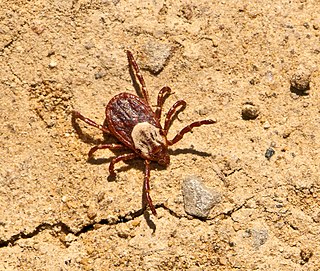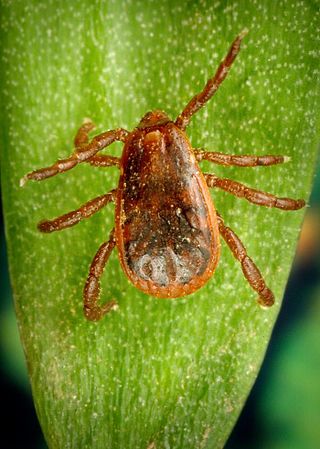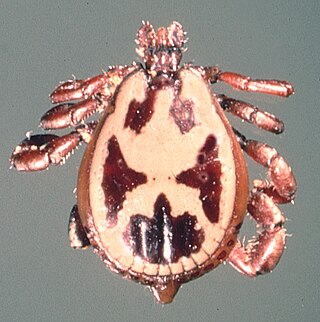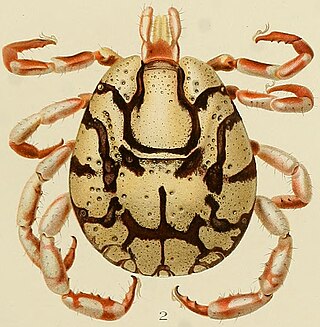Related Research Articles

Ticks are parasitic arachnids of the order Ixodida. They are part of the mite superorder Parasitiformes. Adult ticks are approximately 3 to 5 mm in length depending on age, sex, species, and "fullness". Ticks are external parasites, living by feeding on the blood of mammals, birds, and sometimes reptiles and amphibians. The timing of the origin of ticks is uncertain, though the oldest known tick fossils are from the Cretaceous period, around 100 million years old. Ticks are widely distributed around the world, especially in warm, humid climates.

The Ixodidae are the family of hard ticks or scale ticks, one of the three families of ticks, consisting of over 700 species. They are known as 'hard ticks' because they have a scutum or hard shield, which the other major family of ticks, the 'soft ticks' (Argasidae), lack. They are ectoparasites of a wide range of host species, and some are vectors of pathogens that can cause human disease.

The University of Rostock is a public university located in Rostock, Mecklenburg-Vorpommern, Germany. Founded in 1419, it is the third-oldest university in Germany. It is the oldest university in continental northern Europe and the Baltic Sea area, and 8th oldest in Central Europe. It was the 5th university established in the Holy Roman Empire.
Tick-borne diseases, which afflict humans and other animals, are caused by infectious agents transmitted by tick bites. They are caused by infection with a variety of pathogens, including rickettsia and other types of bacteria, viruses, and protozoa. The economic impact of tick-borne diseases is considered to be substantial in humans, and tick-borne diseases are estimated to affect ~80 % of cattle worldwide. Most of these pathogens require passage through vertebrate hosts as part of their life cycle. Tick-borne infections in humans, farm animals, and companion animals are primarily associated with wildlife animal reservoirs. Many tick-borne infections in humans involve a complex cycle between wildlife animal reservoirs and tick vectors. The survival and transmission of these tick-borne viruses are closely linked to their interactions with tick vectors and host cells. These viruses are classified into different families, including Asfarviridae, Reoviridae, Rhabdoviridae, Orthomyxoviridae, Bunyaviridae, and Flaviviridae.

Nuttalliella is genus of tick. It contains a single living species, Nuttalliella namaqua found in southern Africa, having been reported from Tanzania, Namibia and South Africa. The genus is placed in its own family, Nuttalliellidae. It can be distinguished from ixodid ticks and argasid ticks by a combination of characteristics including the position of the stigmata, lack of setae, strongly corrugated integument, and form of the fenestrated plates. It is the most basal lineage of living ticks.

Ixodiphagus hookeri, the tick wasp, is an encyrtid wasp which lays its eggs into ticks. It seems to use a symbiotic bacteria, Wolbachia pipientis, to weaken the tick's immune system.

Ixodes is a genus of hard-bodied ticks. It includes important disease vectors of animals and humans, and some species inject toxins that can cause paralysis. Some ticks in this genus may transmit the pathogenic bacterium Borrelia burgdorferi responsible for causing Lyme disease. Additional organisms that may be transmitted by Ixodes are parasites from the genus Babesia, which cause babesiosis, and bacteria from the related genus Anaplasma, which cause anaplasmosis.

Hyalomma is a genus of hard-bodied ticks common in Asia, Europe, and North Africa. They are also found in Southern Africa. The name is derived from Greek: Hyalos (ὕαλος) crystal, glass; and omma (oμμα) eye.

Dermacentor is a genus of ticks in the family Ixodidae, the hard ticks. The genus has a cosmopolitan distribution, with native species on all continents except Australia. Most are found in North America.

Rhipicephalus is a genus of ticks in the family Ixodidae, the hard ticks, consisting of about 74 or 75 species. Most are native to tropical Africa.

Ornithodoros is a genus in the soft-bodied tick family, Argasidae.

Haemaphysalis is a genus of ticks, containing these species:

Ticks of domestic animals directly cause poor health and loss of production to their hosts. Ticks also transmit numerous kinds of viruses, bacteria, and protozoa between domestic animals. These microbes cause diseases which can be severely debilitating or fatal to domestic animals, and may also affect humans. Ticks are especially important to domestic animals in tropical and subtropical countries, where the warm climate enables many species to flourish. Also, the large populations of wild animals in warm countries provide a reservoir of ticks and infective microbes that spread to domestic animals. Farmers of livestock animals use many methods to control ticks, and related treatments are used to reduce infestation of companion animals.
Makram Nasri Kaiser (1930–1996) was a medical and veterinary acarologist who was the world's leading authority on ticks of the genus Hyalomma.

The zebra tick or yellow back tick is a species of hard tick. It is common in the Horn of Africa, with a habitat of the Rift Valley and eastward. It feeds upon a wide variety of species, including livestock, wild mammals, and humans, and can be a vector for various pathogens. The adult male has a distinctive black and ivory ornamentation on its scutum.
Brouria Feldman-Muhsam was an Israeli medical entomologist and parasitologist known for her pioneering work with mites and ticks. After earning her Teaching Certificate at Levinsky College of Education in Tel-Aviv in 1935, Feldman-Muhsam enrolled in the University of Geneva in Switzerland and completed her licence ès sciences in biology there in 1937, qualifying her for doctoral studies. She returned to Mandate Palestine in 1937 and earned her Doctor of Philosophy degree in Medical Entomology at the Hebrew University of Jerusalem, graduating in 1942.

Cosmiomma is a genus of ticks first discovered by Paul Schulze in 1919. It is monospecific, being represented by the single species Cosmiomma hippopotamensis. It was first described in 1843 by Henry Denny from specimens collected from a hippopotamus in Southern Africa, and has been called "one of the most unusual, beautiful, and rare tick species known to the world."

Natalia Aleksandrovna Filippova was a world authority on the taxonomy of mites and especially ticks. Her monographs on the identification, morphology, development, distribution and behaviour of the family Argasidae and the sub-families of Ixodinae and Amblyomminae are standard works on these important vectors of disease.
References
- 1 2 Trevor N. Petney, Miriam P. Pfäffle & Jasmin D. Skuballa. 2017. An annotated checklist of the ticks (Acari: Ixodida) of Germany. Systematic & Applied Acarology 17(2): 115–170; https://biotaxa.org/saa/article/view/saa.17.2.2, last accessed 26 Jun 2019.
- 1 2 3 Alberto A. Guglielmone, Trevor N. Petney, Mariano Mastropaolo, and Richard G. Robbins. 2017. Genera, subgenera, species and subspecies of hard ticks (Acari: Ixodidae) described, named, renamed or given new rank by Paul Schulze (1887–1949) and their current status. Zootaxa, Vol. 4325, No. 1 (29 Sept. 2017), https://biotaxa.org/Zootaxa/article/view/zootaxa.4325.1.1; DOI: https://doi.org/10.11646/zootaxa.4325.1.1, last accessed 24 Jun 2019.
- 1 2 Jane B. Walker, James E. Keirans, Ivan G. Horak. 2000. The Genus Rhipicephalus (Acari, lxodidae): A Guide to the Brown Ticks of the World. Cambridge University Press, 2000, p. 519; https://books.google.com/books?id=-tfXTrL9-skC&source=gbs_book_other_versions, last accessed 26 Jun 2019.
- 1 2 3 4 5 6 7 8 9 Universität Rostock: Entry of "Paul Schulze" in the Catalogus Professorum Rostochiensium, URL: http://purl.uni-rostock.de/cpr/00003384 (retrieved on 26.06.2019).
- ↑ Michael Buddrus and Sigrid Fritzlar. 2007. Die Professoren der Universität Rostock im Dritten Reich: ein biographisches Lexikon (The Professors of the University of Rostock in the Third Reich, A Biographical Lexicon). K.G. Saur (An imprint of Walter de Gruyter), München, 2007, pp. 374-376; https://books.google.com/books/about/Die_Professoren_der_Universit%C3%A4t_Rostock.html?id=pHslAQAAIAAJ. ISBN 978-3598117756.